AMD Brazos Platform and AMD E-350 (Zacate) CPU Review

The first new product from AMD that should get the company back to the route of success is the totally new processor family using Bobcat microarchitecture. They are targeted for netbooks and nettops, which is the market where AMD hasn’t been represented at all before. However, will AMD manage to revolutionize this market and push aside Intel Atom and Nvidia ION? Let’s find out!
Recently we have come to begin our reviews of AMD products with thoughts about how very precarious the market standing of that company is. This is actually the obvious conclusion from the fact that for a very long time AMD has not had a competitive processor microarchitecture that might be used in a wide range of products designed for all categories of computers. In fact, the scope of the Stars architecture AMD has been using for over the last three years or something has shrunk so much that AMD processors can only be viewed as a really viable alternative to their Intel counterparts when one is choosing a very inexpensive desktop PC.
Fortunately, this article is going to differ from the general trend and be free from the traditional pessimism about AMD. Times are changing and the year of 2011 may be a new period of renaissance for the company. During this year they are expected to overhaul their entire marketing strategy and unveil a plethora of fundamentally new solutions. The basis of the upcoming changes is a new approach according to which the company will be developing not a single all-purpose microarchitecture but a few of them, each with different parameters and each optimized for a specific class of computers.
Intel, on their part, have been following this approach for a long time already. As you know, they offer three basic microarchitectures: the Itanium for servers, the Core for general purpose computers and the Atom for low-power-consumption devices. AMD is going to do the same by offering the Bulldozer microarchitecture for servers and workstations, the Llano microarchitecture for midrange computers, and the Bobcat one for energy-efficient and compact systems.
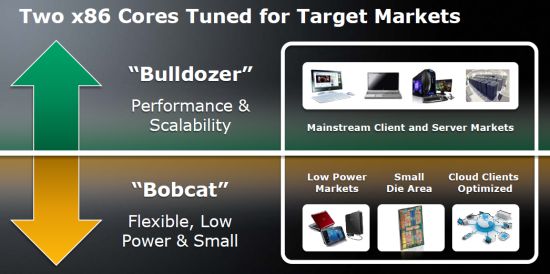
AMD has taken to the practical implementation of the new strategy from bottom upwards. The Bobcat is the first new microarchitecture to be embodied in silicon, namely in two processor series codenamed Ontario and Zacate. If you throw away all the marketing chaff, you will wind up seeing that these processors are nothing else but a response to Intel’s Atom. The key feature of both the Ontario and the Zacate is that they are highly integrated and rather fast processors with low power consumption. In other words, they are going to be AMD’s somewhat belated, yet still important, step towards the now-fashionable netbooks and nettops and, later on, tablet PCs.
In this review we will be talking about what is called Brazos, the typical nettop platform as envisioned by AMD. AMD’s vision is quite conventional, though. Like same-class solutions from Intel, AMD and its mainboard-making partners are proposing mini-ITX products for nettops: a mini-ITX mainboard with an integrated processor and various onboard controllers that make it unnecessary to install add-in cards. Like Intel’s Atoms, the Zacate processor contains an integrated graphics core, thus making the AMD Brazos a complete all-in-one computing platform.
Traditionally for AMD, a rather high-performance integrated graphics core is a strong point in favor of AMD’s solution. Zacate-based mini-ITX mainboards are going to be far more appealing than Intel’s platform whose graphics subsystem cannot even play HD video. But it is not so easy to tell how the Brazos is going to compare with the popular ION platform that combines Intel’s energy-efficient Atom processor with high-performance graphics from Nvidia. We will try to answer this question in this review.
Bobcat Microarchitecture
AMD’s energy-efficient processors codenamed Ontario and Zacate are based on new cores with the Bobcat microarchitecture. The main goal that the AMD engineers pursued when developing it was to minimize the chip’s power consumption as much as possible. Bobcat-based processors are meant for applications and devices where the one processor core has a power consumption of 1 to 10 watts only.
No wonder that the Bobcat has little in common with the well-known Stars microarchitecture. Like Intel’s engineers that developed the Atom, AMD’s specialists had to give up a lot of features and think about cutting off everything unnecessary to lower the power draw of the resulting chip. The outcome looks more like AMD’s K6 processor rather than like a modern Phenom.
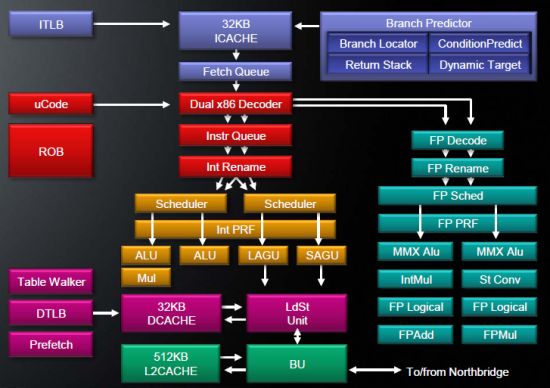
However, the Bobcat has retained the key feature of modern CPU microarchitectures as it supports out-of-order execution. This is the main difference of AMD’s approach from Intel’s. Intel’s Atom does not support out-of-order execution of instructions in order to save more power whereas the problem of making full use of all of the CPU subunits is solved by Hyper-Threading technology that enables one CPU core to run two instruction streams simultaneously.
AMD does not have anything like Hyper-Threading, so its new processor has a classic scheduler that is responsible for reordering incoming instructions. Howeover Bobcat scheduler uses a physical register file, not a centralized retirement register file. The physical register file contains links to register contents and makes it unnecessary to transfer data within the processor when there are changes in the order of instructions. Intel has implemented a similar solution in the Sandy Bridge series, by the way. A physical register file reduces the amount of data transfers within the processor and saves power but also increases the depth of the execution pipeline which is as long as 15 stages in the Bobcat.
Of course, the new processor from AMD has a branch prediction unit whose operation has a great effect on the energy efficiency of the whole thing. AMD’s engineers have tried to improve this unit once again, so in the Bobcat microarchitecture it can predict up to two branches per clock cycle and process indirect branching as well as return statements.
Overall, the Bobcat microarchitecture can execute two x86 instructions, including 64-bit ones, simultaneously. Of course, the processor actually works with its own internal microinstructions, but from a statistical point of view, up to 89% of x86 instructions are transformed by the Brazos decoder into one symmetric microinstruction. About 10% of x86 instructions are decoded into a pair of microinstructions and no more than 1% of incoming x86 commands are translated inside the processor into a sequence of several micro-operations. Thus, it is quite likely that the Bobcat will be processing two x86 commands per clock cycle most of the time. This can give us some notion about the level of performance we can expect from the new microarchitecture, by the way. The clock rate being the same, it is theoretically only two thirds as fast as the Stars (K10) microarchitecture.
As it is optimized to perform two instructions per clock cycle, the Bobcat has two integer ALUs, a couple of data ports and two 64-bit FPUs which also perform integer multiplication. Bobcat-based processors support SIMD instruction extensions up to SSSE3 and SSE4A but do not support AMD’s own 3DNow! extensions. The recent instruction sets like AESNI and AVX are not supported, either.
The Bobcat’s cache system consists of a 64-kilobyte L1 cache, one half of which is for data and another for instructions, and a 512-kilobyte L2 cache which is clocked at half the clock rate of the rest of the processor. Each CPU core has dedicated L1 and L2 caches. Multi-core Bobcat implementations do not have a shared cache.
Of course, the Bobcat microarchitecture is also optimized for energy efficiency. The processor supports power-saving states up to C6 and can turn off unused L2 cache sections.
Brazos Platform
The Brazos platform is intended by AMD as a basis for compact and energy-efficient systems. It consists of a Bobcat-microarchitecture processor with integrated graphics core and a highly integrated mainboard with appropriate chipset.
At the current moment, AMD offers two types of processors as a part of Brazos platform. They are codenamed Ontario and Zacate. The former has a heat dissipation of 9 watts and is targeted at the netbook market. The latter has a TDP of 18 watts and is meant for nettops and entry-level desktops as well as for inexpensive notebooks.
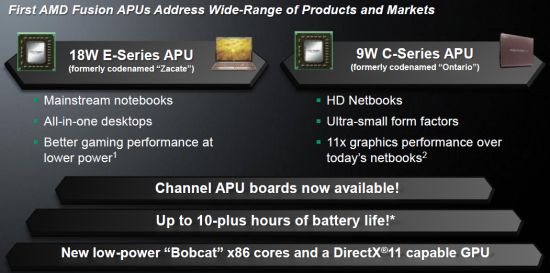
Both types of processors feature two Bobcat cores and a DirectX 11-compatible graphics core of the Mobility Radeon HD 6000 class. The advanced graphics is one of the key distinguishing features of AMD’s energy-efficient processors in comparison with Intel’s Atoms. The Ontario and Zacate also have a PCIe 2.0 x4 controller and an integrated memory controller that supports single-channel DDR3-1067 SDRAM. All of the mentioned components reside in a single semiconductor die manufactured on 40nm tech process at TSMC facilities.
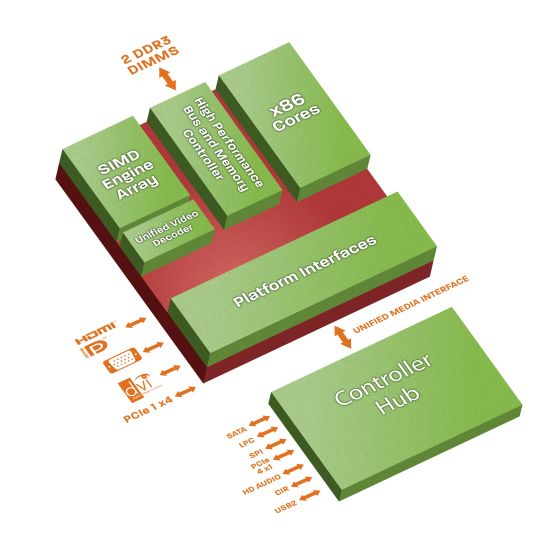
Bobcat cores are compact and the Ontario and Zacate were designed with energy efficiency and low manufacturing cost in mind, therefore the semiconductor die is very small, measuring a mere 75 square millimeters. To give you some reference point, this is even smaller than the size of Pineview-core Atom processors.
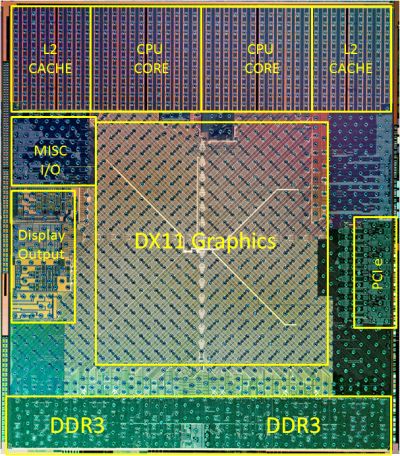
Notwithstanding the compact dimensions, the Ontario and Zacate silicon contains a full-featured Cedar graphics core with two SIMD units each comprising 40 stream processors. The graphics core also has eight render output units. In the multimedia department, it features a third-generation Unified Video Decoder that offers hardware acceleration for video playback in MPEG-2, VC-1 and H.264 formats. Thus, the Ontario and Zacate can be said to incorporate a graphics core like the Radeon HD 5450 with DirectX 11 support.
It is the incorporation of an advanced graphics core into these new energy-efficient processors that gives AMD the reason to call them not just central processing units (CPUs) but accelerated processing units or APUs. The new term has been coined to additionally emphasize the compatibility of the integrated graphics core with the OpenCL and DirectCompute APIs as well as the availability of the hardware HD video decoder UVD3. This means that the graphics core can offload the CPU in certain applications, improving the overall system performance.
At the current moment, the model range of the Ontario and Zacate APUs includes four products:
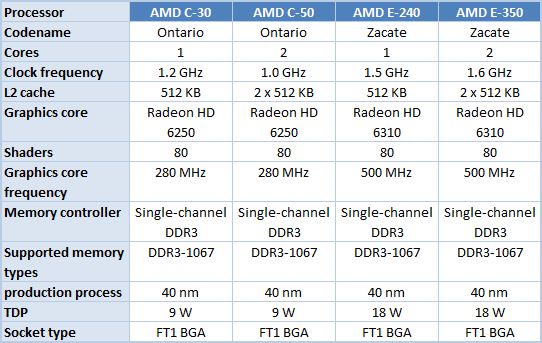
The Ontario and Zacate specifications make it clear why AMD makes such a point of calling them APUs rather than conventional CPUs. The graphics core incorporated into them is far!20more advanced than the general computing core. While the CPU part with the Bobcat microarchitecture is comparable to the Intel Atom, i.e. represents a rather weak CPU by today’s standards, the Cedar graphics core with 80 stream processors is perhaps one of the highest-performance integrated graphics available today. Of course, when coupled with a low-speed CPU, it is going to be redundant for classic 3D applications, such as games, because it will be limited by the CPU performance. The benefits of the high-performance graphics core witl advanced computing resources are going to become apparent in traditional computing tasks.
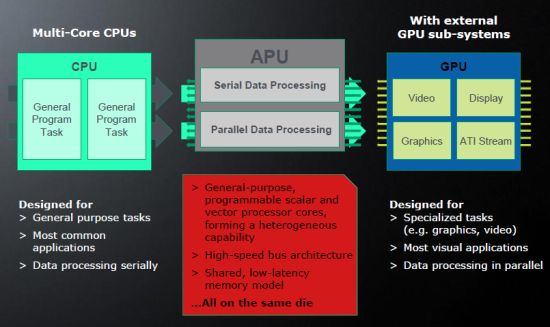
Of course, this calls for further improvements of the GPGPU concept and for making GPGPU-compatible applications widespread. In fact, this work has been underway for a while already but now we can really hope that there will be more such applications available. There are currently only a few programs that are optimized for AM@’s new APUs but they already include not only conventional video players or video transcoding tools. There are next-generation browsers (particularly, Internet Explorer 9) and, for example, some office applications (PowerPoint 2010) that can make full use of the capabilities of Ontario- and Zacate-based systems. Thus, AMD’s APU concept has a chance to make low-performance CPUs with the Bobcat microarchitecture appealing to the end-users with something else than just low pricing.
Besides an APU, the Brazos platform includes a companion chip that adds`support for peripheral interfaces. The chip is called Hudson FCH (Fusion Controller Hub) and supports six SATA 6 Gbps (without RAID option), 14 USB 2.0 ports, four PCIe 2.0 lanes, and HD Audio among other things.
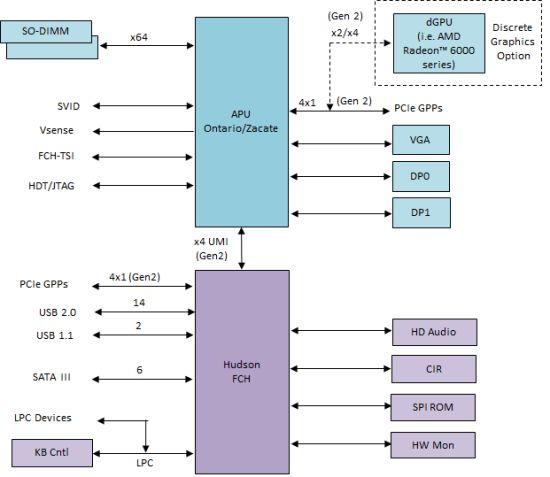
And again AMD made sure the chip wouldn’t be a big energy consumer. Being rather simple, the Hudson is manufactured on 65nm tech process and has a TDP of 4.7 watts, which means that the peak power consumption of the whole Brazos platform in its maximum configuration targeted at nettops and fast netbooks is only 23 watts. This is 30% lower than that of the second-generation ION, by the way, making the Brazos look like a next-generation “ION”: the multimedia capabilities of the Ontario and Zacate APUs are no worse than those of the Nvidia ION, the computing performance is comparable to that of the Intel Atom, and the power consumption and heat dissipation are very low as well.
MSI E350IS-E45 Mainboard
AMD has been kind to offer us a typical mini-ITX mainboard that might be used for nettop implementations of the Brazos platform. It is not an engineering sample but an off-the-shelf product from MSI that sells under the model name of E350IS-E45 (MS-7698).
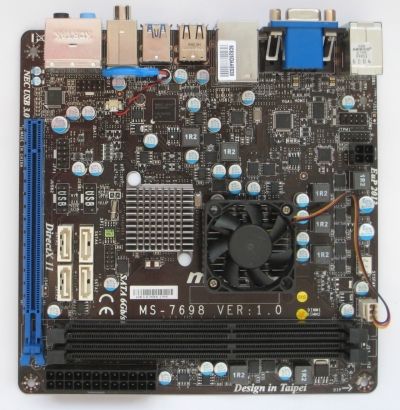
MSI’s Brazos-optimized mainboard lacks any pretense for being special. It is an inexpensive product that is going to win the user’s heart with its affordable price rather than with some exotic functions. The price is about $130, by the way, which seems to be very moderate considering that the MSI E350IS-E45 is a complete platform with a CPU and a graphics core. You only need to install system memory, connect a hard disk and power supply, and you are ready to go.
The MSI E350IS-E45 is based on two chips: an AMD E-350 (Zacate) APU and a Hudson M1 chipset.
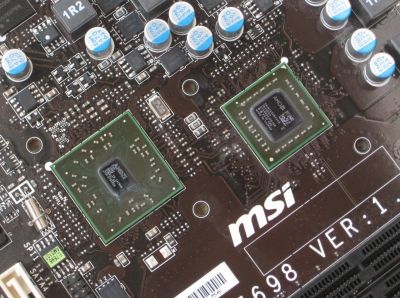
The processor contains two Bobcat computing cores, clocked at 1.6 GHz, with 512 kilobytes of L2 cache for each.
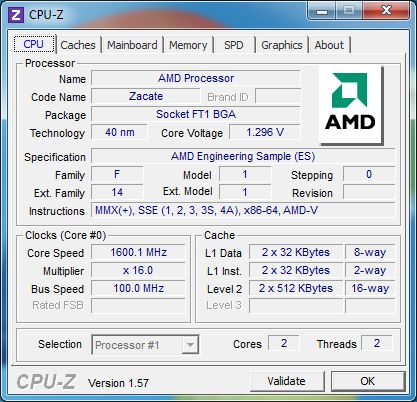
The integrated graphics core has 80 shader processors and a clock rate of 500 MHz.
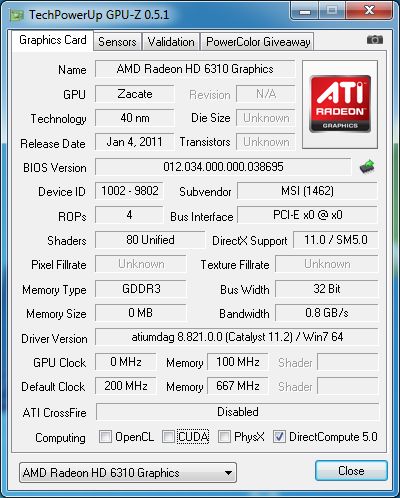
The capabilities of the Zacate+Hudson pair are broad enough to implement everything necessary for a modern nettop in the mainboard alone. MSI engineers only added a Gigabit Ethernet controller (Realtek RTL8111E), an eight-channel audio codec (Realtek ALC887) and a USB 3.0 controller from NEC. With so few chips on board, the mainboard has a simple PCB design with quite a lot of free space, despite its tiny mini-ITX form-factor.
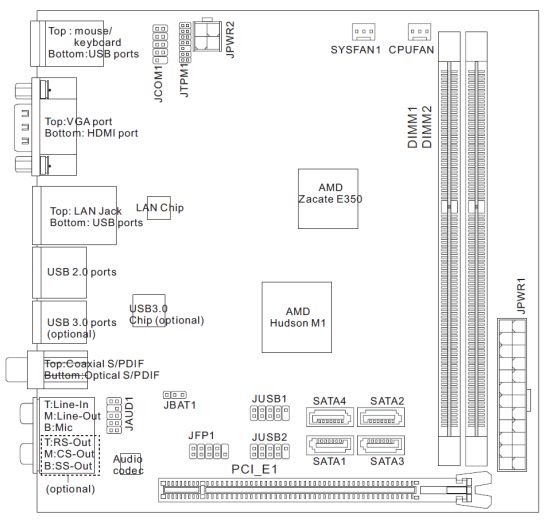
There are two DDR3 DIMM slots here but you should keep it in mind that the Zacate APU only has a single-channel memory controller, so you cannot enable dual-channel access even if you install two memory sticks. There is also a PCI Express x16 slot on the mainboard. It is connected to the processor’s PCI Express x4 interface and can be used to extend the mainboard’s functionality with an add-on card. You can even install a discrete graphics card into it if you want to.
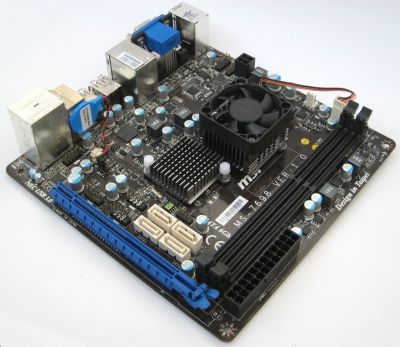
The mainboard’s back panel offers six USB 2.0 ports, two USB 3.0 ports, a PS/2 port for mouse/keyboard, a Gigabit Ethernet connector, six analog audio connectors, coaxial and optical SPDIF outputs, and video outputs (analog D-Sub and digital HDMI). You can use the two video interfaces simultaneously. Some users might prefer a DVI connector instead of the D-Sub, but MSI thinks that the analog output is going to be a more demanded feature in a nettop. So if you need DVI, you will have to find an appropriate adapter because it is not included into the mainboard box.
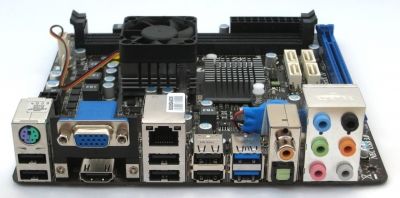
On the mainboard’s PCB there are four SATA 6 Gbps connectors and headers for four additional USB 2.0 ports. All in all, this is quite a full and sufficient selection of interfaces for a modern compact computer.
The mainboard is powered up via standard ATX connectors, a 24-pin and a 4-pin one, but its power consumption is really very low as is indicated by the simple 3-phase CPU voltage regulator which even lacks any cooling device. The processor and chipset are only cooled with small aluminum heatsinks, so they do not seem to generate too much heat, either. There is a fan on the CPU heatsink, though. Being small and noisy, it may become a problem for users of this mainboard.
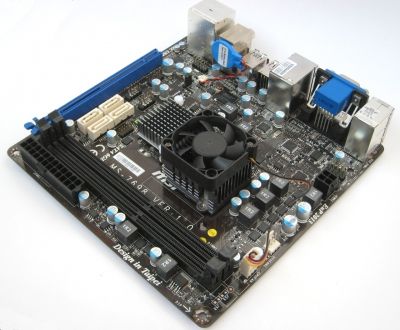
Instead of conventional BIOS this mainboard offers the new-fangled UEFI but this shouldn’t provoke any problems as this particular UEFI interface is stylized to resemble the old-school BIOS. In fact, the number of user-defined settings is rather limited here. You can change the memory frequency and timings and control the CPU fan. There is no opportunity to overclock the computing or graphics cores as every clock rate is fixed at its default level.
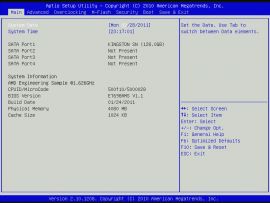
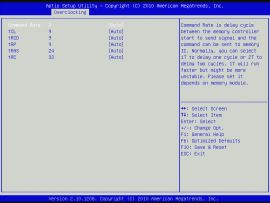
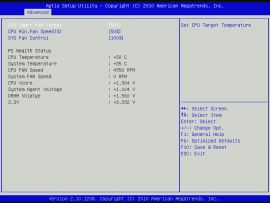
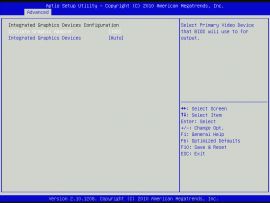
Here is a list of the mainboard specs as provided by MSI.
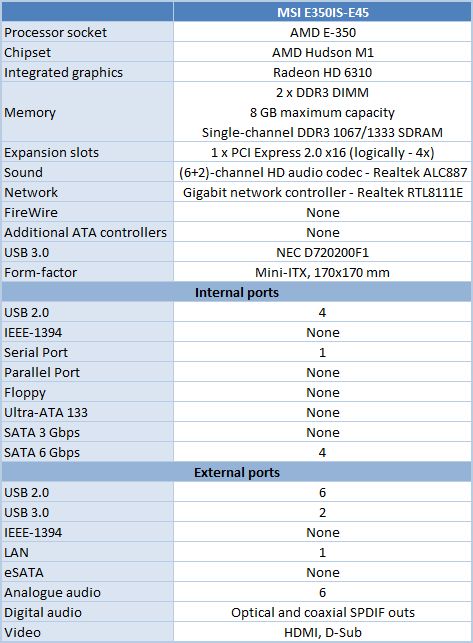
Testbed and Methods
AMD Brazos platform with the Zacate processor is positioned for nettops and netbooks used not only for simple internet surfing and work in productivity applications, but also for work with multimedia content, including HD content. It means that Brazos falls into the same niche that is currently fully occupied by systems based on ION platforms including Intel Atom processors and Nvidia graphics. Therefore, we are going to compare Brazos against solutions based on ION and ION 2.
I would like to remind you that the currently existing ION modifications differ primarily by the processor: the first ION is based on Intel Atom with Diamondville core, while the second generation of the platform uses a newer processor codenamed Pineview. We got both these platforms represented by Mini-ITX mainboards, like our MSI E350IS-E45, for the tests.
The first ION platform will be represented by Zotac IONITX-D-U built around a dual-core Intel Atom 330 processor and a chipset with Nvidia GeForce 9400 graphics core. The new-generation ION is represented by a truly unique Asus AT5IONT-I that uses the today’s fastest Intel Atom D525, Intel NM10 chipset and Nvidia GT218 graphics core with 16 shader processors and 535 MHz clock speed.
As a result, our testbeds were configured as follows:
- Mainboards:
- ASUS AT5IONT-I (Intel Atom D525 + Intel NM10 Express + NVIDIA GT218);
- MSI E350IS-E45 (AMD E-350 + AMD Hudson M1); Zotac IONITX-D-U (Intel Atom 330 + GeForce 9400).
- Memory:
- 2 x 2 GB DDR2-800 SDRAM DIMM (GEIL GX24GB8500C5UDC) 5-5-5-15;
- 2 x 2 GB DDR3-1333 SDRAM DIMM (Kingston KHX1600C8D3K2/4GX) 9-9-9-27;
- 2 x 2 GB DDR3-1333 SDRAM SODIMM (Apogee AS2G733-13G) 9-9-9-27;
- Hard drive: Kingston SNVP325-S2/128GB.
- Power supply unit: Tagan TG880-U33II (880 W).
- Operating system: Microsoft Windows 7 SP1 Ultimate x64.
- Drivers:
- ATI Catalyst 11.2 Display Driver;
- Intel Chipset Driver 9.1.1.1025;
- NVIDIA ION Chipset Driver 15.51;
- NVIDIA GeForce/ION Driver 266.58.
I would also like to note that the nettop platforms we tested this time have dramatically different characteristics, despite their similar market positioning. To illustrate this statement we put together a comparative table showing the major distinguishing features of each platform tested today:
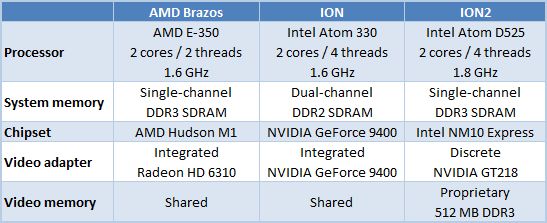
Performance
Synthetic Benchmarks
We don’t often use synthetic benchmarks in our mainboard reviews because their results generally have little practical value, but we’ve got a special case today as we are studying the all-new Bobcat microarchitecture. That’s why we will run tests from the SiSoftware Sandra 2011 that help evaluate the performance of different CPU subunits regardless of the overall platform speed. Using those tests we will be able to see the strong and weak aspects of the new microarchitecture in comparison with Intel’s first- and second-generation Atoms.
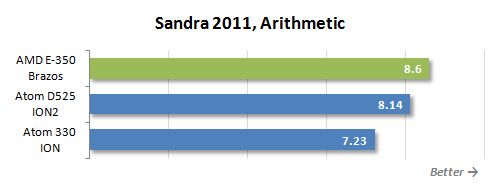
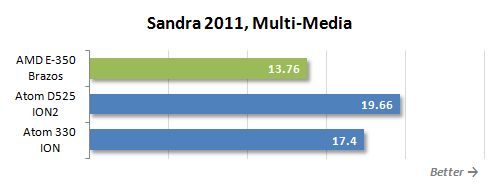
The 1.6GHz Zacate is somewhat faster than both Atoms, the old 1.6GHz model and the new 1.8GHz one, in terms of arithmetic performance but is not so good in terms of multimedia which is benchmarked by Sandra 2011 as the speed of processing SSE2 and SSE3 instructions. Thus, we cannot see the AMD solution being overwhelmingly superior to its opponents. Although AMD claims that its energy-efficient processor supports out-of-order execution and should be faster, Intel’s Hyper-Threading can make up for Intel’s simplified microarchitecture in terms of performance in practical applications.
Now let’s check out the performance of the CPU-integrated memory controllers.
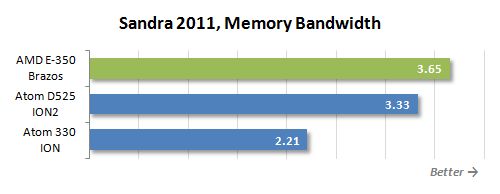
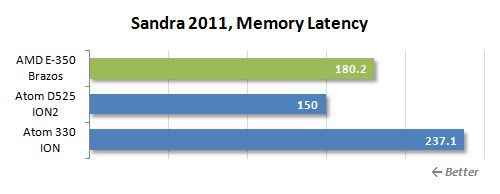
The numbers suggest that the integrated single-channel DDR3 SDRAM controllers of the AMD Zacate and Intel Atom (Pineview) processors are roughly equal to each other.
We can also use Sandra 2011 to benchmark the computing performance of the integrated graphics cores. The test suite contains a special GPGPU test that is based on calculating the Mandelbrot set and utilizes OpenCL.
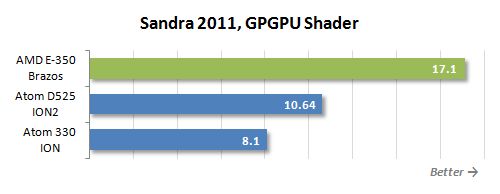
Well, AMD’s processor has something to impress us with. The integrated graphics core is more than 50% faster than the second-generation ION. We might have expected that, though. The Radeon HD 6310 core has as many as 80 stream processors, which make it very good at general computing tasks.
General Performance: PCMark Vantage
We will use the popular PCMark Vantage suite to benchmark the average performance of the systems in practical tasks.
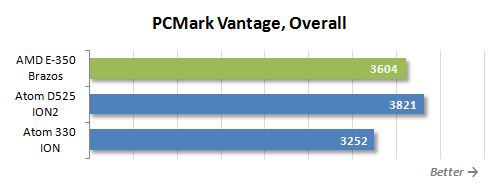
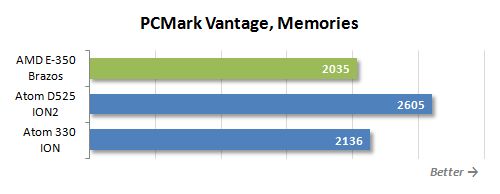
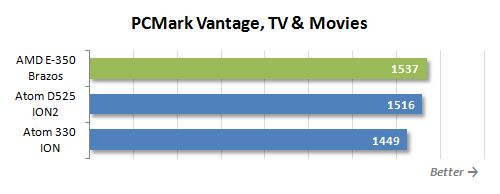
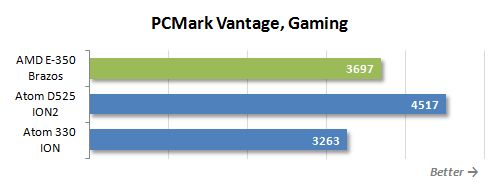
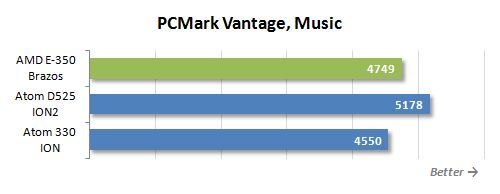
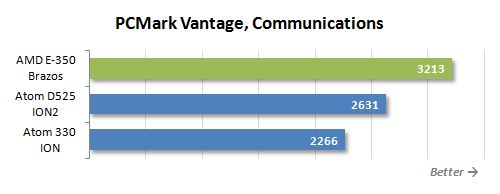
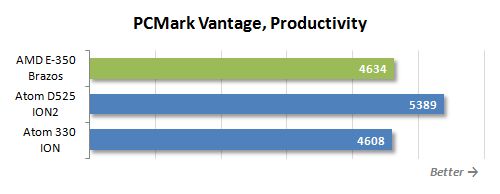
The AMD Brazos platform is overall faster than the first-generation ION which is based on the Diamondville-core Atom. It doesn’t mean that Intel’s energy-efficient platform can’t compete with AMD’s solution. The new 1.8GHz Atom coupled with Nvidia’s graphics beats the Brazos across most of the tests. The gap isn’t very large, yet we can see that the Zacate is no Atom killer when it comes to everyday tasks. It should rather be viewed as an alternative offer from AMD.
Internet Applications
Browsing the Web is a typical usage scenario for nettops, so we are going to have some web page rendering tests in this review. What makes such tests even more interesting, next-generation browsers are expected to make full use of the APU’s resources, i.e. they are able to utilize the graphics core to accelerate the rendering of web pages and to execute JavaScript and HTML5 code. Therefore we are going to perform these tests with the release candidate of Internet Explorer 9 and with the beta version of Mozilla Firefox 4.
The first thing we should note is that the browsers can indeed make use of the various capabilities of the Zacate processor. The APU load graph indicates that the stream processors of the integrated Radeon HD 6310 graphics core are utilized even when we are just simply surfing through websites.
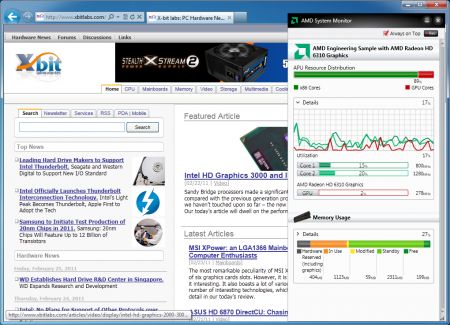
By the way, this is not a unique feature of the Brazos platform. We would see the same picture with any computer where the graphics card (or the integrated graphics core) supports Direct2D and DirectCompute.
Now we will use two tests to obtain numeric results for the performance of the platforms when running web browsers: the new HTML5 benchmark Stimulant WebVizBench and Futuremark Peacekeeper which focuses on the speed of processing JavaScript.
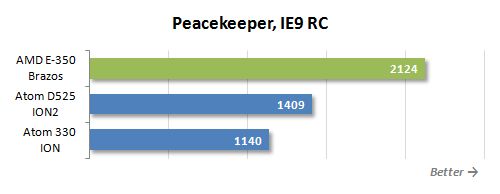
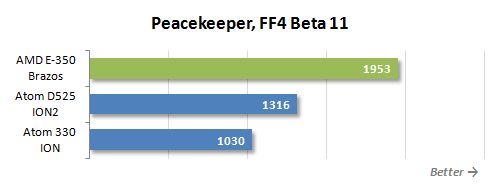
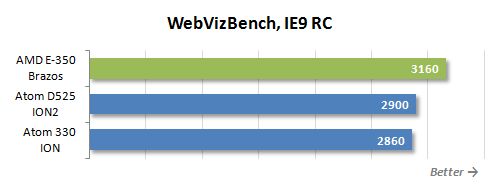
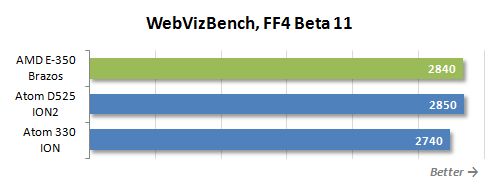
The Brazos platform copes with the web benchmarks better than both generations of IONs, just as we might have expected. The Brazos APUs offer higher graphics performance than Nvidia’s graphics cores of the ION platform, so web browsers that can utilize graphics core resources run faster on the AMD platform.
On the other hand, we cannot yet call the Brazos an ideal web platform because not all of today’s web technologies can be accelerated by the APU. Particularly, Flash technology is not supported and works only on the CPU (except when playing video). It means that resource-consuming Flash applications are going to work on the AMD Brazos (and on the ION, for that matter) slowly and with high CPU load. This is confirmed by the results of our tests in the Flash-based 3D massively multiplayer online game Tanki Online. We used Adobe Flash Player 10.2 for that.
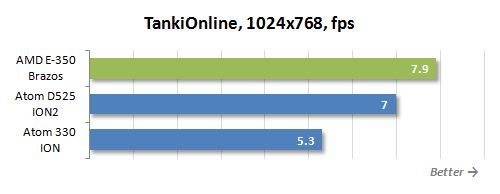
Well, the frame rates are low even at low resolutions. The speed of the AMD platform is of course higher but not much higher than that of the second-generation ION.
Performance in Desktop Applications
We use WinRAR to measure the performance of processors when compressing data. We take a folder with a lot of files for a total amount of 560 megabytes and compress it into an archive with the highest compression settings.
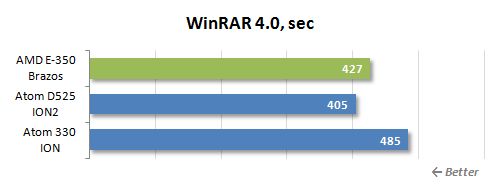
The Intel Atom D525 is about 5% faster than the AMD E-350 at archiving. The older Atom 330 is inferior to AMD’s energy-efficient processor, though.
We use our custom-made test to benchmark computers with Adobe Photoshop. It is a redesigned Retouch Artists Photoshop Speed Test involving some ordinary processing of four 10-megapixel images captured with a digital camera.
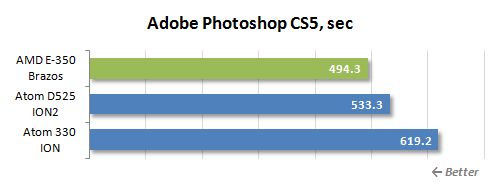
When processing images, the Brazos platform proves to be somewhat faster than both generations of the ION platform.
We use the Apple iTunes utility for our audio transcoding test. We convert an audio CD into AAC format. Take note that Apple iTunes can only make use of two CPU cores.
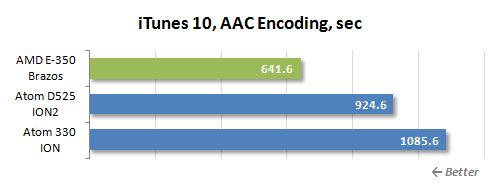
Apple iTunes runs in two execution threads, so the Atom’s Hyper-Threading technology is of no use here. This explains why the AMD Zacate wins this test.
To measure the speed of encoding video into the H.264 format we use the x264 HD test that involves the processing of original MPEG-2 video recorded at 720p resolution with a bit rate of 4 Mbps. By the way, the results of this test have huge practical value because the x264 codec is employed in a variety of transcoding utilities such as HandBrake, MeGUI, VirtualDub and others.
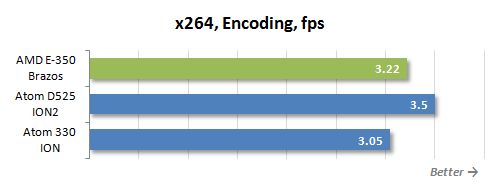
The Atom D525 based system is better at encoding video using CPU cores.
The speed of final rendering in Maxon Cinema 4D is benchmarked with the Cinebench test.
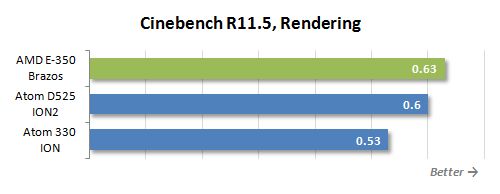
The results are low but the AMD E-350 processor is somewhat faster than both the Atom 330 and the Atom D525.
Next, we will use the integrated CPU test from the chess program Fritz to benchmark the systems.
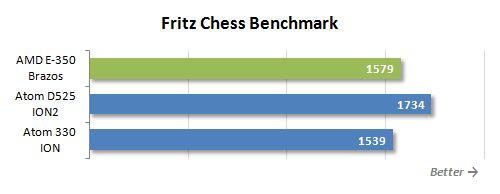
Here, the 1.8GHz Atom is in the lead whereas the Atom 330 is almost as fast as the AMD Zacate.
Overall, our tests in different applications indicate that the Atom D525 and AMD E-350 are very close to each other in terms of traditional computing capacities. Either of them can be a little faster, depending on the specifics of the particular application.
3D Gaming Performance
First of all, let’s take a look at the results produced by Futuremark 3DMark Vantage.
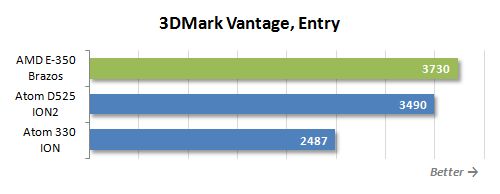
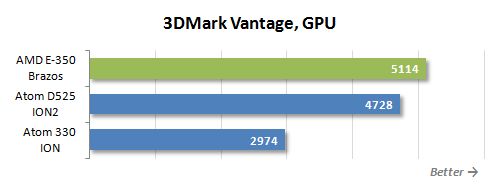
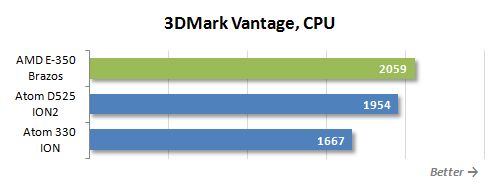
This popular gaming benchmark gives a rather high score to the Zacate processor’s integrated graphics core Radeon HD 6310. We can see that it is comparable to Intel’s first-generation HD Graphics in terms of performance. As a result, the performance rating of the AMD platform is even higher than that of the second-generation ION which, by the way, is equipped with a discrete rather than an integrated graphics core.
On the other hand, it is obvious that we cannot expect as high gaming performance from the Brazos as from platforms with Core i3/Core i5 processors. The AMD Zacate is energy-efficient and slow, therefore the gaming performance of the whole platform is going to be limited by the processor’s capabilities even at low graphics quality settings and low resolutions.
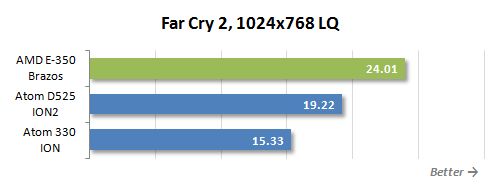
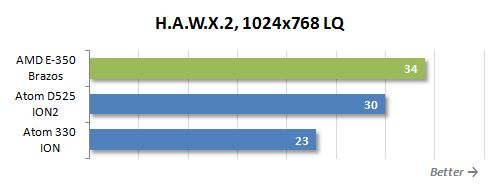
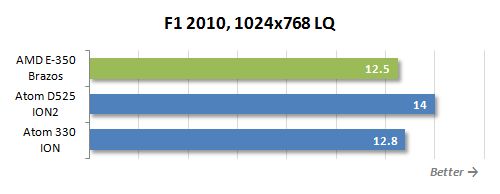
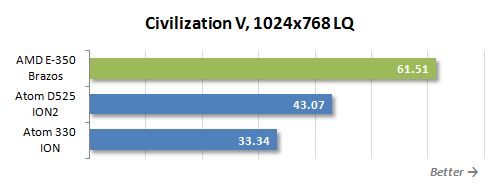
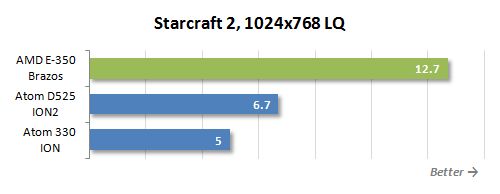
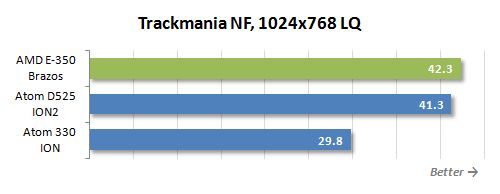
Well, that’s just what we expected. Reviewing any Intel Atom based platform, we always wrote that it would be highly problematic to build a full-featured gaming system around it. The processor is just too slow. AMD’s offer isn’t much different from the Atom in this respect. Like the ION, the Brazos is not a gaming platform as you can only achieve a playable frame rate on it in but a limited number of 3D games. So, Brazos users can only try to run casual or old games with low system requirements on their platform.
HD Video Playback and Encoding
Processors with the Bobcat microarchitecture do not have enough computing resources to decode high-definition video but they can get help from the integrated graphics core which is equipped with the UVD3 video engine. It means you can watch HD video in MPEG-2, H.264 and VC-1 formats on the Brazos platform without any problem as the graphics core offloads the CPU when performing such tasks. There is only a problem with 3D video. The Zacate’s graphics core cannot decode MVC, therefore it is impossible to play 3D video on Brazos-based nettops.
When it comes to playing conventional video, our tests did not reveal any problems with HD video playback in any of the popular formats. The diagrams below show the CPU load level when playing different video clips at 1080p resolution. We used Media Player Classic Home Cinema. The test clips had the following parameters: H.264, 1920×1080@23.976 fps, 23.7 Mbps and VC-1, 1920×1080@23.976 fps, 26.9 Mbps.
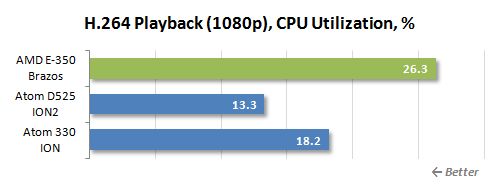
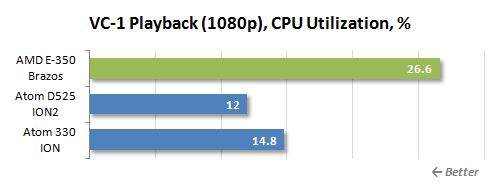
The CPU load on the Brazos platform is no higher than 30% and we couldn’t see any flaws in the playback quality. Thus, AMD’s new platform is a perfect choice for small and energy-efficient media centers and HTPCs. It is similar to the ION platform which has already found its place in such systems.
By the way, you should not think that the ION is better at decoding video because the CPU load is lower for that platform. The fact is that the dual-core Atom with Hyper-Threading technology is identified by the operating system as a quad-core processor, so the CPU load results reported in this test are lower than the real load on the CPU cores.
Besides checking out the capabilities of the Brazos platform in terms of playing MPEG-2, H.264 and VC-1 videos, we will check it out et reproducing video streamed over the Internet. Fortunately, Adobe Flash Player 10.2 is familiar with the Radeon HD 6310 core and can use its UVD3 engine to get some hardware acceleration. It means that Flash-based video players are perfectly compatible and work at low CPU load on the AMD Brazos platform. The next diagram shows the CPU load numbers when playing a 1080p video from YouTube.com.
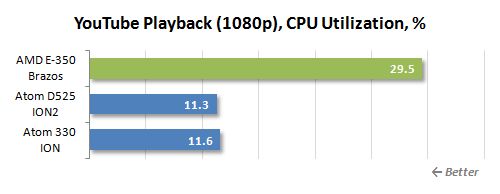
The exact numbers are very similar to those we got when playing ordinary video clips. Thus, the Brazos platform is going to have no problems with online video services.
The UVD3 can be used for other purposes besides video playback. Particularly, it can be employed by various video transcoding tools that take some video clip, decode it and encode into a new format. The AMD Brazos platform is already supported by the popular commercial utilities Arcsoft Media Converter and CyberLink Media Espresso, so we are going to see how fast our systems are at such a job, especially as both applications can also utilize the Nvidia CUDA technology on the ION platforms. We measured the time it took to transcode a small H.264 1080p video clip into an iPhone 4 friendly format (H.264, 1280×720, 4 Mbps).
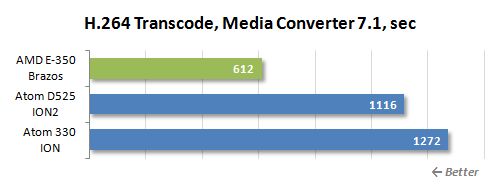
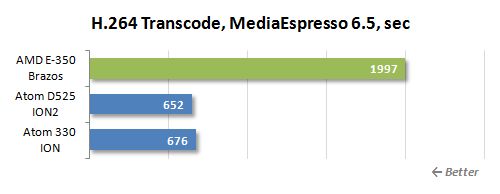
Funnily enough, we’ve got completely different results in Arcsoft Media Converter and CyberLink Media Espresso. The CyberLink application obviously prefers the ION platform whereas the Arcsoft utility runs faster on the AMD Brazos. This can be explained by how these`tools employ the APU resources offered by AMD. CyberLink Media Espresso decodes video using the UVD3 engine and then encodes it using the ordinary x86 computing cores. As opposed to that, Arcsoft Media Converter makes use of the Stream/APP technology and compresses the video clip using the graphics core’s stream processors. The second approach is more effective and the transcoding process takes less time on the AMD Brazos than on the ION platform.
Still, we must confess that, for all the optimizations implemented in the vidao transcoding tools, the ION and the Brazos are both rather slow at converting video clips. You must be prepared that converting an HD movie into a mobile-friendly format is going to take a lot of time, sometimes much more time than the length of the movie itself.
Power Consumption
As we have already found out, the AMD Brazos platform is all right in terms of performance, at least if used in netbooks and nettops. However, these devices also require that the platform had low power consumption and heat dissipation. The Bobcat microarchitecture was designed to be highly energy-efficiency and the TDP of Zacate APUs only 18 watts. But what do we have in practice, especially in comparison with the existing and quite successful ION platform?
The graphs below show the full power draw of the computer (without the monitor) measured after the power supply. It is the total of the power consumption of all the system components. The PSU’s efficiency is not taken into account. The CPUs are loaded by running the 64-bit LinX 0.6.4 utility. Graphics cores were loaded using FurMark 1.8.2 utility. Moreover, we enabled all power-saving technologies to ensure that computer power draw in idle mode was measured correctly.
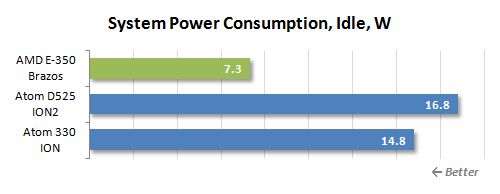
When doing no work at all, the Brazos has fantastically low power consumption. In fact, it is the most economical platform in idle mode that we have ever seen and tested. Clearly, AMD made a right decision by implementing deep power-saving states in its new energy-efficient processor microarchitecture. The turning off of unused circuits in the semiconductor die comes in handy, too.
By the way, Intel’s Atom processors are not that progressive in this respect. Trying to make them cheaper, Intel cut off a lot of technologies that help minimize power consumption in idle mode. On the other hand, the rather high power draw of both versions of the ION platform is due to the chipset and graphics core rather than to the CPU.
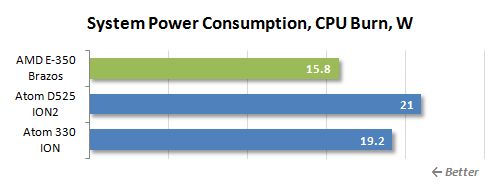
The AMD Brazos remains the most economical nettop-oriented platform under high computing load, too. The difference from the second-generation ION amounts to 5 watts although the Zacate’s TDP is 5 watts higher than that of the Atom D525.
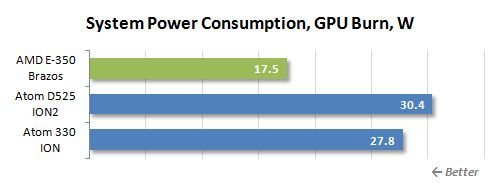
The graphics load emphasizes the high energy efficiency of the AMD Brazos platform even more. Although the Radeon HD 6310 graphics core integrated into the AMD Zacate processor delivers high performance, it is absolutely blameless in terms of power consumption.
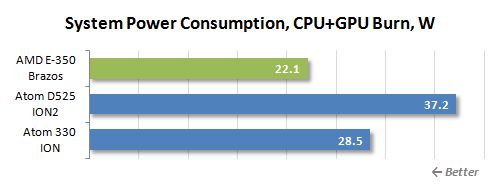
We can see everything even more clearly when the systems are under full load, the computing and graphics cores all together. AMD has developed a very economical platform for nettops and netbooks which can compete with the best available alternatives. The results of our tests suggest that Brazos-based netbooks are going to have a very long battery life.
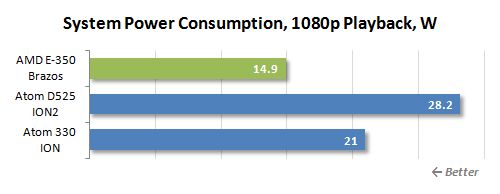
HD video playback is yet another kind of complex load. When used as a video player, our systems do not change their standings in terms of power consumption, though. The AMD Brazos needs only half the power that the second-generation ION consumes. The first-generation ION is more voracious than the Brazos, too.
Considering these results, we guess we should be disappointed that our Brazos-based MSI E350IS-E45 mainboard is equipped with active cooling. The Zacate processor can obviously do with only a passive heatsink unless it is a bare chunk of aluminum with no fins at all. Hopefully, mainboard makers will release AMD-based products for nettops without such small and load fans as the one installed on our MSI mainboard.
Conclusion
We can view the introduction of the AMD Brazos platform and of the Ontario and Zacate processors based on the Bobcat microarchitecture from different standpoints. For example, AMD can be said to finally release its own version of Intel’s Atom which, however, cannot boast any advantages in terms of performance. Thanks to the out-of-order execution, these new processors from AMD feature high single-threaded performance but the senior Zacate model is overall only as good as the Intel Atom D525 in most real-life applications.
However, this is only one, and rather superficial, point of view. The Zacate and Ontario processors in the AMD Brazos platform are not just energy-efficient CPUs similar to the Intel Atom. They are highly integrated APUs that, besides a conventional x86 processing core, incorporate a high-performance graphics core with up-to-date functionality. This endows AMD’s solutions with completely new features compared to the Atom. For example, they can play HD video with minimum CPU load or quickly process web pages with JavaScript and HTML5 or run some other optimized applications that can make use of the graphics core’s stream processors.
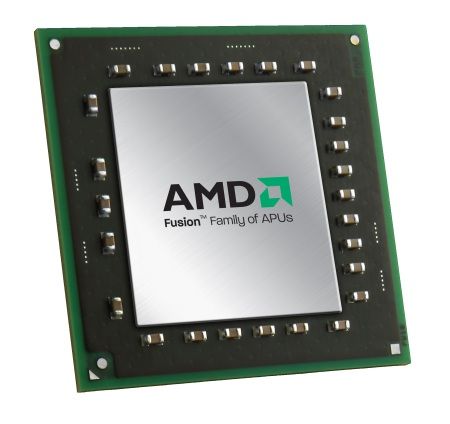
Considering this broad functionality of the Zacate and Ontario, the Brazos platform can be viewed not just as an alternative to the Pine Trail but as a new energy-efficient multimedia platform, like the ION, for example. Moreover, the Brazos even comes as an alternative to a non-existing third-generation ION because the first- and second-generation ION solutions are greatly inferior to AMD’s new platform. Particularly, the integrated graphics core of the new APUs delivers higher performance than the ION graphics and also supports DirectX 11.
And while Nvidia has no opportunity to develop its platform for the Intel Atom due to the lack of a license for the processor bus, AMD offers a similar platform for nettops and netbooks with broad multimedia capabilities, full HD video support and vast GPGPU resources. As opposed to the ION platform which is built out of Intel and Nvidia components, AMD offers a complete and integrated solution, so the Brazos is superior not only in energy efficiency but also in terms of pricing.
As a result, the AMD Brazos seems to be the best option available for tiny and power-efficient stationary and mobile computers. AMD took a long time to develop its energy-efficient microarchitecture and postponed it a number of times. As a result, the company is late to the nettop and netbook boom but finally has a really competitive solution. Without a doubt, the Brazos platform is superior to other available platforms of this class. It is a kind of a new Athlon XP among energy-efficient processors. AMD has proved its engineering ability with this release, which looks like a promising symptom after all the recent failures.
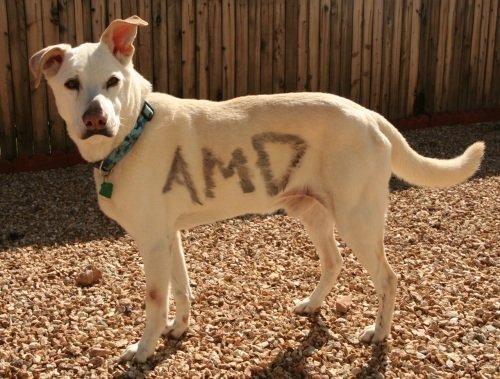
But again, users have already lost their initial interest in products of this class and AMD will not be able to rake in profits by benefiting on consumer’s interest towards completely new products. The AMD Brazos platform will surely sell more or less successfully but the company will have to put much effort and choose a flexible pricing policy to ensure a market success for its Zacate and Ontario processors as well as computers based on them. It is tablet PCs that are the hot topic today but our tests cannot say if Bobcat-based processors can be employed in such systems. AMD has plans to reduce the power consumption of that processing core even further but it is unclear when these plans are going to be implemented in actual products.